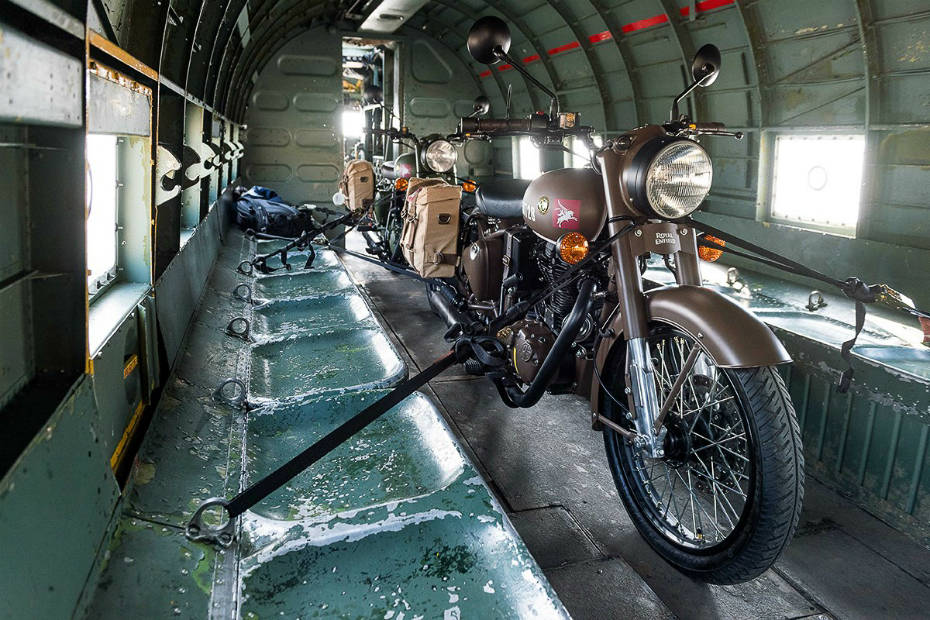5 Things To Know About The Royal Enfield Pegasus
Modified On Mar 20, 2019 01:28 PM By Team Bikedekho for Royal Enfield Classic 500
- 13487 Views
Post its international launch last week, the Classic 500 Pegasus is set to enter India on 30th May. Here’re five facts to give you an insight on what the Pegasus Edition is all about.

The Royal Enfield Classic 500 Pegasus is a tribute to the RE/WD 125cc ‘Flying Flea’ built in collaboration with the British Army's Parachute Regiment. The Flying Flea was a small and nimble motorcycle which proved to be an invaluable asset for the British army during the Second World War and Normandy D-day invasion.
Only 1,000 units of this limited edition motorcycle will be available worldwide, of which 250 units will make it to Indian shores on the 30th of May, 2018. We list down 5 exciting facts that will help you understand the bike and its history much better.
The legend of the Flying Flea (WD/RE) -

Royal Enfield has a history of military manufacturing, where they supplied ammunitions, artillery equipment and motorcycles during both World Wars. Being one the major suppliers of motorcycles during both the wars proved that the bikes could endure the toughest of conditions. And thus the legendary trademark ‘Made Like a Gun’ was coined.

Then there’s Royal Enfield’s most treasured creation during the Second World: the ‘Flying Flea.’ Out of the tens of thousands of Royal Enfield motorcycles serving in the war, the Flying Flea was the only motorcycle to be dropped behind enemy lines alongside paratroopers. The compact two-stroke 125cc motorcycle was so capable that the War Department ordered over 4,000 of them to serve in the war. The ‘Classic 500 Pegasus’ is a tribute to this very bike and Royal Enfield’s military heritage, and just 1000 units of it will go on sale worldwide.
The ‘Flying Flea’ in WWII -

The story takes us back in time, to World War II, where tens of thousands of RE’s served as faithful companions besides soldiers. The British, though, were interested in a very special lot of motorcycles, christened the Flying Flea. The small size and sheer lightness of the motorcycle meant it could be packaged in a round tubular birdcage crate and parachuted along with airborne troops.
Designed to be simple and tough, these bikes were deployed extensively at the forefront of battles. Furthermore, owing to their rugged and versatile character, they could be used as scouts or messengers.

The Flying Flea’s headlight was equipped with a military-issue top brow, which restricted the throw of light, helping it remain undetected from enemy aircrafts. The fuel tank cap had a built-in measuring tube to ensure riders mixed oil and fuel at the recommended ratio. And the whole bike was painted in military green so as to keep a low profile. The sheer lightness of the bike is what made it so usable in the Second World War, in contrast to the Classic 500 which is heavy and not nearly as nimble.
Encounter a ditch, fence or river and the soldier could simply carry the bike across and get going again. Its simple but practical design also meant it could be easily fixed with the bare minimum tools.
In addition, the Flying Flea had a vital role to play during the D-Day operation, where these motorcycles were used as a means of rounding up troops, getting them forward and also acting as a convoy escort.
The design of the Pegasus -
It’s easy to see that Royal Enfield hasn't gone back to the drawing board to completely redesign the bike, as it’s still a standard Classic 500 underneath. Instead, they have simply endeavoured to capture the essence of the Flying Flea with a simple heritage paint job and some accessories to complement the overall theme.

The bike comes with a set of military-style canvas panniers bearing the “Pegasus” logo. Heavily inspired by the Flying Flea, the Classic 500 Pegasus will also feature brown handlebar grips and leather strap accents along with blacked out mechanicals. Royal Enfield has also introduced a range of riding gear and motorcycle accessories to go along with the heritage theme.

The Classic 500 Pegasus will come in two wartime liveries: Service Brown and Olive Drab Green; except in India, where only Service Brown will be available. Olive Green is only permissible for defense use, so commercial vehicles cannot be painted in the same colour. As the name suggests, each of these machines will wear a maroon and blue Pegasus emblem on the fuel tank. To add more exclusivity, the tank will also feature an individual stenciled serial number and the trademark ‘Made Like a Gun’ decal on the battery box.
Specifications -

The WD/RE a.k.a Flying Flea ran on a 125cc, air-cooled, 2-stroke, single-cylinder motor which produced a claimed power of 3.5PS at 4,500rpm. Top speed was 72kmph and it tipped the scales at 59kg. It had a fuel tank capacity of 8 litres, which gave a mileage of 440km, impressive even by today’s standards!
The Classic 500 Pegasus on the other hand will use the same engine as seen on the standard Classic 500 variant. It’s a 499cc, single-cylinder, air-cooled mill which churns out 28PS at 5,250rpm and 41Nm of peak torque at 4,000rpm. Mechanicals remains the same too.
Pricing & Availability -

The limited edition Classic 500 Pegasus has been launched in UK at an on-road price of GBP 4,999 (approx Rs 4.56 lakh). While 190 units of the model have been allotted for the UK, there’s no word on how many will make it to Indian shores. The Classic 500 Pegasus which will be launched in India on the 30th of May, and is expected to be priced around Rs 2 lakh (ex-showroom). To know more click here.
